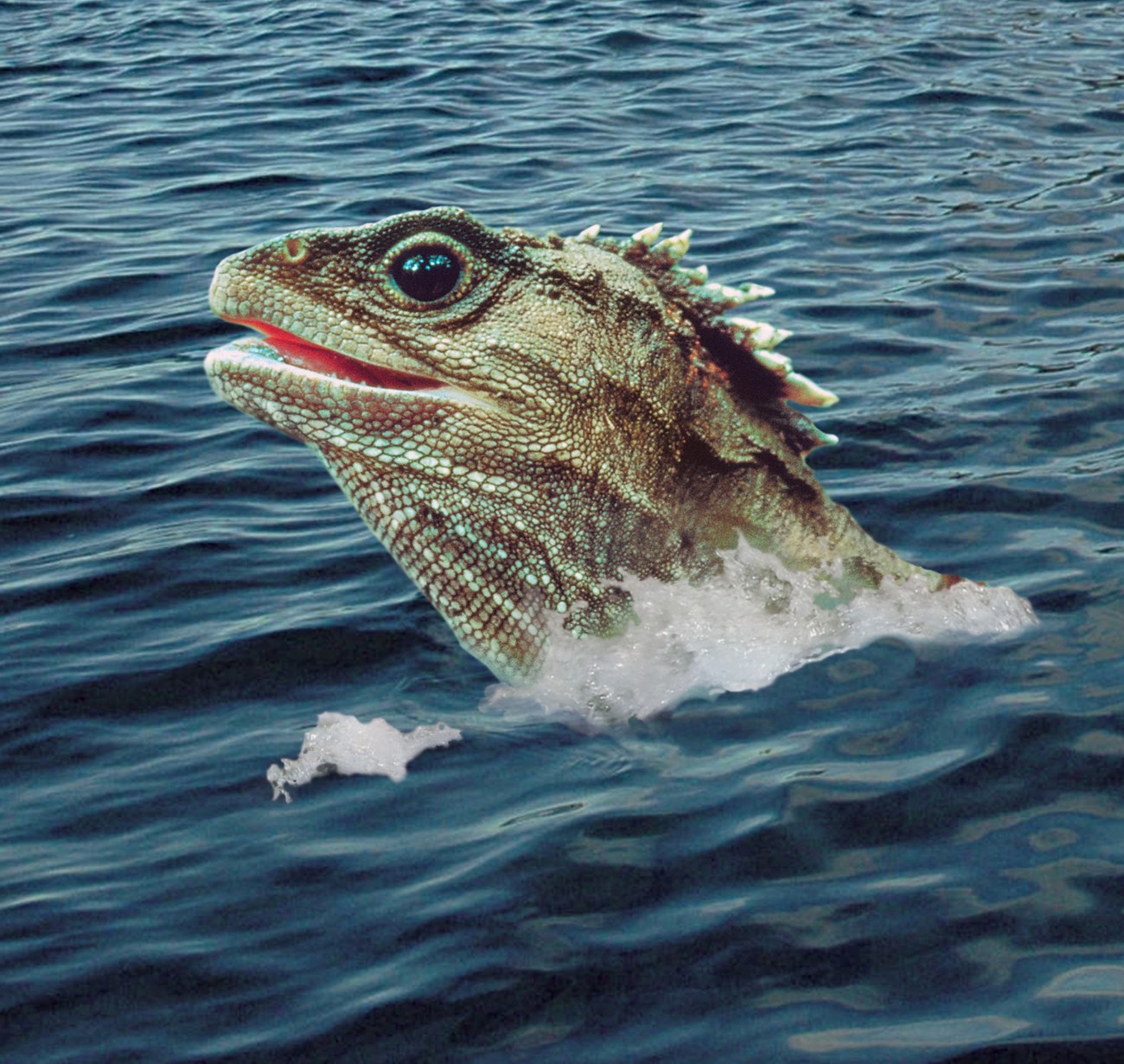
Chips off the old block
Parallel but different universes on each side of the Tasman.
The mossy crust of an old beech log gives way with a crunch under my boot and crumbles into woody Weet-Bix. I brush away the mahogany-coloured chips of timber and look for another place to set up my camera tripod. I’m experiencing rainforest sensory overload. Scenes tumble over and into each other as I try to find the perfect vantage, the defining image. Bracket fungi as big as pudding plates jut from the trunks of living beech trees, and wisps of lichen beard trail from overhead branches. Scarlet caps of Hygrophorus fungi push through a moist confetti of leaves on the forest floor. Stately tree ferns, each with a skirt of dead fronds girdling its trunk, flank an amber-coloured stream, and the leaves of tall dracophyllums rattle like flax as my pack brushes against them.
I could be in Fiordland, or perhaps in Nelson Lakes, but I’m not. I’m 2500 km further west, in the central highlands of Tasmania—although I could just as easily be in Patagonia, because this type of beech forest and its associated species, down even to the edible beech strawberry fungi which sprout on southern beech in the warmer months, is a botanical signature of these widely separated lands.
The connection, of course, is Gondwana. Since the 1960s the concept of New Zealand as a “moa’s ark”, tectonically adrift from the ancestral supercontinent for 80 million years, bearing a cargo of ancient biological treasures, has become part of our origin myth. Although aspects of the myth have been challenged by recent scientific discoveries (see sidebar, “Gondwana—the long goodbye”), its geological foundation is uncontested: New Zealand, South America and Australia (together with Africa, India, Antarctica, New Caledonia and New Guinea) are all chips off the old block.
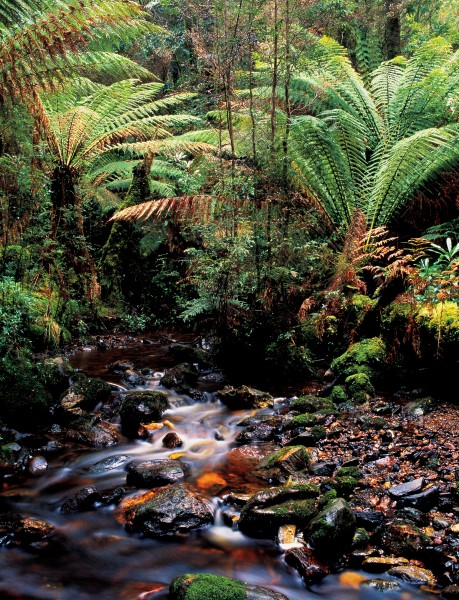
In Tasmania’s Pine Valley, in Cradle Mountain–Lake St Clair National Park, the family resemblances are all around me—a case of ecological déjà vu. Besides the well-buttressed beech (which Australians call myrtle), the tree ferns (here called man ferns) and the Tasmanian equivalent of our Dr Seuss tree, called pandani, there are podocarps such as the celery-top pine (close in genetics and name to our celery pine, or tanekaha), and coprosmas, blechnum ferns and orchids.
There are many novelties, too: sassafras, whose leaves smell of sarsaparilla when crushed and make a palate-tingling tea; King Billy pine, with scaly leaves reminiscent of Norfolk pine; and something known as “horizontal”. This diabolical shrub grows upwards, then droops down under its own weight, then sends up new branches, which again grow weary of standing up, the result being a snarl of stout branches that defies human passage. Most startling of all (for a Kiwi) are eucalypts, their massive trunks thrusting through the canopy of beech and podocarp and towering above the rest of the forest—something, of course, that is never seen on this side of the Tasman.
The greenness of Tasmania—which despite two centuries of logging still retains 40 per cent forest cover—seems an anachronism in a country known for its aridity. Geographically, Tasmania is more similar to New Zealand than it is to the rest of Australia. At one time, however, the whole of Australia was blanketed in temperate, Tasmanian-style rainforest. It is only in the past two million years that climate fluctuations have dramatically reduced forest cover north of Bass Strait and made Australia “the sunburnt country”.
New Zealand and Tasmania share more than just geography. We had the same European discoverer, for one. Three weeks before he reached New Zealand, Tasman sailed down the west coast of his namesake island, calling it Van Diemen’s Land in honour of his patron, Anthony van Diemen, Governor-General of the Dutch East Indies. (The governor’s wife is remembered in New Zealand’s Cape Maria van Diemen). Although the island’s name was changed to Tasmania in 1856, a number of radicals and non-conformists continue to call themselves Vandemonians, rejecting what they consider to be the colony’s snobbish attempt to distance itself from its convict past.

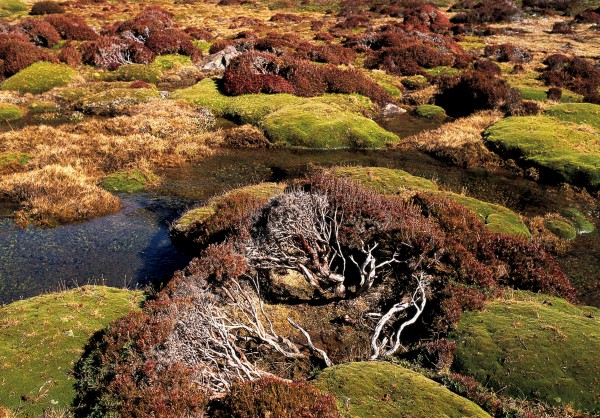
A pro-British mentality is something else we had in common: we were both eager-to-please colonial siblings, “Englands of the south”, satellite farms and orchards of the Mother Country. (Tasmania was once known as “the apple isle” because of its pip-fruit exports—and perhaps coincidentally because on a map it resembles an apple.) We also share an ongoing political debate over the stewardship of natural resources, especially forests and fresh water: how to strike a balance between exploitation and preservation.
I set out to write about the Gondwanan affinities of our respective islands, basing my observations on two weeks of tramping and exploring in Tasmania with my Melbourne-based daughter. But the other parallels kept crowding in, so my story has turned out to be about more than a shared geography: it traces our common threads of history as well.
[Chapter Break]
We started our journey in the south-west, climbing through buttongrass and banksias and snow-laden eucalypts on the route to Mt Anne. To the south, gleaming like sheet metal, lay the many arms of Lake Pedder. Or “New Lake Pedder”, as some people call it. Or the “Huon–Serpentine Impoundment” to Tasmanians who cannot bring themselves to utter the name of what to them is the epitome of the state’s environmental shame. The lake that was drowned.
Photographs of the original Lake Pedder show a sapphire set in a glacier-carved landscape. Its 3 km-long, 1 km-wide beach of pink quartzite must have been a dazzling sight on a summer’s day, and the Serpentine River—aptly named for its meandering course—was also much admired.
It is fair to say that “Electric Eric” Reece, Tasmania’s premier during the 1960s and early 1970s, admired pristine wilderness lakes less than he admired hydro powerhouses with turbines spinning at full speed, generating cheap electricity, attracting industry and providing jobs. Despite public opposition, three dams were built, and in 1972 the lake started to expand. Yet as the water level rose, so did Lake Pedder’s importance as a symbol of change. It became a watershed for environmental consciousness not just in Tasmania but in the rest of Australia as well. Just as the proposed raising of Lake Manapouri’s level was an environmental watershed in this country, the flooding of Lake Pedder was, as historian Randall Doyle writes, “the tipping point and beginning of a new chapter in Tasmanian history”. Prior to Pedder, the use of natural resources for economic benefit had never been publicly challenged. In the quarter-century since the inundation, the exploitation of Tasmania’s natural resources has rarely gone unchallenged.

Feelings of betrayal and regret over the loss of the lake remain keen to this day. Occasional campaigns are mounted to gain support for draining the impoundment. A 1993 study found that the original beach, dunes, shoreline and riverbed remain intact under a layer of silt and 15 m of water—a Sleeping Beauty awaiting its prince.
Standing on the control structure of the Edgar Dam—a concrete dyke around which hung wreathes of winter mist—and peering down into the dark waters, I could see nothing of the lake’s former life. I wondered, though, if a plaque would have been in order, quoting Tasmanian landscape photographer Olegas Truchanas, a Lithuanian immigrant whose images of Lake Pedder were a powerful galvanising element in the protest: “This vanishing world is beautiful beyond our dreams and contains in itself rewards and gratifications never found in an artificial landscape or man-made objects.”
Truchanas drowned while preparing for the next big protest against the threatened disappearance of a piece of the beautiful world, the Franklin River. Plans had been announced in 1978 to build a dam on the Gordon River below its confluence with the Franklin, creating a reservoir which would have destroyed the Franklin’s wilderness character, along with stands of native forest and a cave containing evidence of the southernmost human occupation during the last ice age. One Australian senator described the plan as an “environmental obscenity”.
Four years of public debate, a change of state government and a referendum on the issue failed to get the project shelved. Then, in 1982, a new green-leaning state senator by the name of Bob Brown upped the ante by organising a blockade of the dam site. It began on the very day that a large swathe of southern and western Tasmania—including the site of the proposed dam was declared a World Heritage area.
Over the summer of 1982–83, 50 people a day were ferried down the Gordon River to the blockade site. More than 1200 arrests were made, and 500 people (including Brown, dubbed the “Schweitzer of the rivers”, and British botanist David Bellamy) were imprisoned.
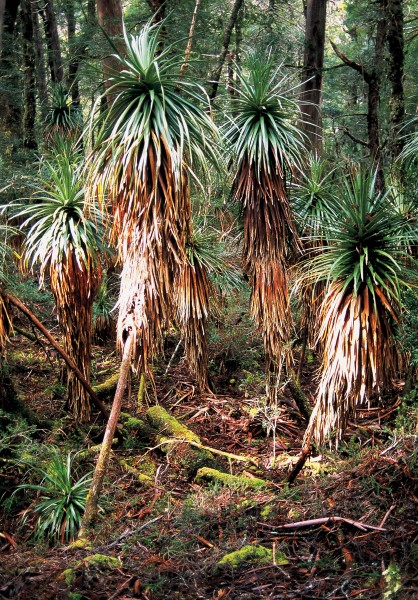
It was, writes Doyle, the “largest exhibition of mass civil disobedience in Australian history”. It would eventually bring down the government of Malcolm Fraser and lead to the formation of the first Green political party in the world.
The federal government had declined to intervene in the Lake Pedder protest, on the grounds that it had no constitutional authority to overrule a state’s decision. However, the Franklin situation differed in one fundamental way: the dam site was in a World Heritage area. The federal government argued that it had an international obligation to comply with the terms of the UNESCO listing, which included protecting the site from clearance and excavation. (A law, the World Heritage Protection Bill, had been passed to this end.) Tasmanian premier Robin Gray disregarded the law—and a $500 million offer by Canberra to build a thermal power station instead of the proposed hydro dam—and told Fraser not to meddle in Tasmania’s affairs, threatening Tasmanian secession from the Commonwealth if he did so.
Eventually, it was the Australian High Court that decided the matter, coming down 4–3 in favour of the federal government, now under the leadership of Bob Hawke, who had made opposition to the dam part of his election campaign. The Franklin scheme was abandoned, and, apart from a couple of small dams constructed as part of a compromise deal, Tasmania’s hydro-electric hegemony was over.
[Chapter Break]
It is an ironic commentary on changing times and attitudes that a century earlier hydro-electricity had been hailed as an ecological saviour because it ended the mass felling of forests to fuel the mining industry. In Tasmania as in New Zealand, only more so, mineral extraction was a foundation of the pioneer economy. (Today it is the state’s most important source of revenue, with forestry in second place.) Mining made Tasmania’s west coast economically, but unmade it ecologically. The steam engines, concentrating mills and smelters of the copper and tin mines devoured millions of cubic metres of firewood. In the late 1800s, a thousand or more woodcutters were engaged in de-timbering the hillsides.
The results were devastating. “Fires swept through the hills in summer, burning even the black peat that coated the underlying rock, and the sulphurous fumes pouring out of the chimney stacks prevented regrowth,” writes Melbourne geographer and historian Geoffrey Blainey. “Heavy rains eroded what remained of the topsoil, exposing the ribs and flanks of the steep hills.” Towns like Zeehan and Heemskirk (named after Tasman’s ships) began to resemble the Western Front. “The totem of the west was a black stump,” says Blainey.
Turn-of-the-century feminist Marie Pitt, a miner’s wife, wrote of that period:
They slew the pine and sassafras,
The myrtle host laid low
Tramping through the button-grass…
Forty years ago!
The advent of hydro was seen as a godsend to the forests. The inundation of a few valleys was a small price to pay for the preservation of beech, eucalypt and pine. “Nobody could conceive of a time when hydro and the valleys which it drowned would become a prime source of complaint from nature lovers,” notes Blainey. A further consequence of the canning of hydro as an energy source is that Tasmania has had to meet the shortfall by drawing on gas- and coal-fired generation—both of which are now regarded as environmental liabilities. Such is the unpredictability of the relations between humans and nature. Today the denuded landscapes of the west have been softened by regrowth. Queenstown, created to service the Mt Lyell copper mine, is reminiscent of historic New Zealand mining towns like Thames and Waihi. Its residents evidently possess a wry sense of humour: the tourist sign on the tortuous road into town carries the slogan “Queenstown, Around the Bend”.

Even before the mining boom and its associated forest slaughter, the pick of the west-coast timber trees, Huon pine and King Billy pine, had been heavily culled. Huon pine, like New Zealand’s kauri, was prized as a boatbuilding timber. Its pale, close-grained heartwood contains an inbuilt preservative, methyl eugenol, which protects it from rotting and gives it a distinctive smell. (The same aromatic compound occurs in bananas, anise, cloves, nutmeg, basil and walnuts, and is used as a flavouring essence in ice-cream, soft drinks and bubble gum.)
Huon pine, whose name derives from the explorer Jean-Michel Huon de Kermadec, is not a true pine, but a podocarp with a lineage that has been traced back 100 million years to Gondwanan times. Its closest living relative is New Zealand’s manoao, the silver pine. Huon pines are immensely long-lived, reaching ages of between two and three thousand years—botanical Methuselahs whose longevity is exceeded only by the North American bristlecone pine.
In Strahan, a former sawmilling town on Macquarie Harbour now reinventing itself around tourism, Huon-pine products, from coffee tables to rolling pins, are sold in classy waterfront craft outlets. Other endemic timbers are showcased, too. Sassafras, with characteristic black-stained areas resulting from bacterial infection, looks especially striking.
Classic Huon-pine launches are moored at jetties around the harbour. Many are used for lobstering, as evidenced by stacks of pots on the deck. The pots are all the traditional bun shape, made of tea tree and wire, something no longer seen in New Zealand.
A retired miner who greeted me when I stopped to buy a pot of blackberry jam from a roadside stall told me Macquarie was one of the few harbours in the world where no tide tables were produced. The combined force of river outflow and offshore wind at the heads could block an incoming tide for days, he said, and even when the harbour was flushed by fresh seas the tide heights and times were erratic.
Travelling north, we took the Fatman punt—a raft on a wire rope that ferries vehicles across the Pieman River (named after an escaped convict who happened to be a pastry cook)—to the town of Corinna. Like all rainforest-fed rivers in Tasmania, the Pieman was dark with tannins, its banks thickly forested with lush, albeit secondary, growth. In its heyday, during a gold rush in the 1890s sparked by the discovery of a 7 kg nugget, the town boasted 700 residents. Now, the manageress of the local store and tourist-accommodation complex told me, its population was “two, plus a thylacine dog”. This latter specimen was a well-fed, lick-you-to-death pooch, “part blue heeler, part Staffordshire, part dingo”, whose tawny fur had been dyed to imitate the stripes of the extinct Tasmanian tiger.
Extinct? Officially, yes. The last known thylacine (a.k.a. zebra opossum, zebra wolf, hyena tiger, greyhound tiger, opossum hyena, panther and Tasmanian dingo or wolf) died in Hobart Zoo in 1936. But according to a recent book—one of several that have been published in the past decade to meet the public’s seemingly insatiable interest in the iconic beast—one in three Tasmanians has a “true” tiger-sighting story. Tasmania’s Parks and Wildlife Service employs a man to follow up such sightings, but so far no confirmation of a living tiger has resulted. A $1.25 million reward offered by national news and current affairs magazine The Bulletin in 2005 for conclusive evidence of the thylacine’s survival went unclaimed.
Not that Australia hasn’t had its takahe-type rediscoveries of species presumed extinct: there was the mahogany glider (a possum with a parachute) in 1989, and a rock rat in 1996. But the tiger has eluded all detection. DNA analysis of presumed thylacine scat collected in the 1950s and 1960s is in progress, and, as with the Fiordland moose, a positive ID may push forward the date of last survival.
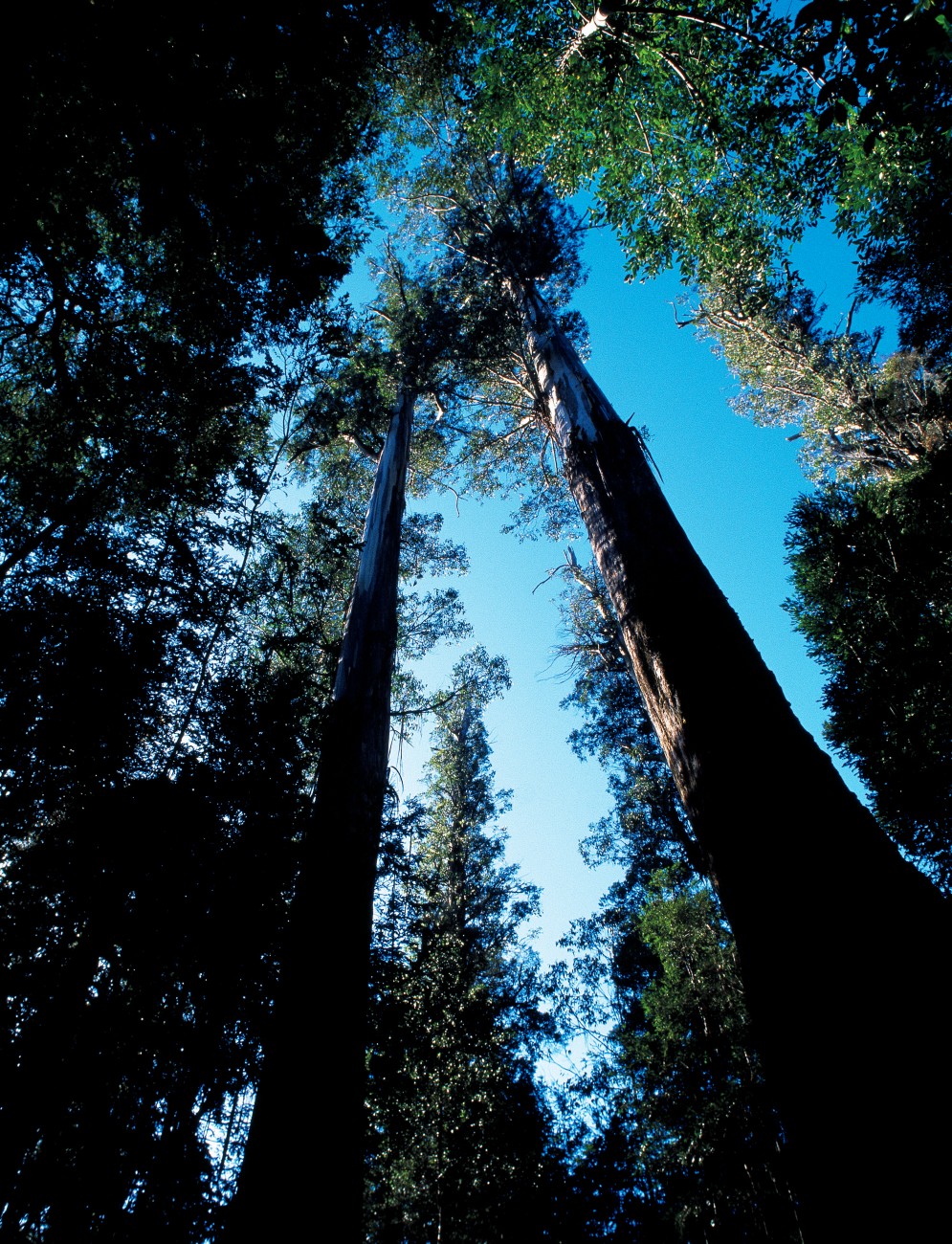
In 2000 there was a much-publicised attempt by the Australian Museum to clone a thylacine from DNA extracted from a pickled century-old pup. The Sydney Morning Herald reported the story under the headline: “Get a Life, Scientists Tell Extinct Tiger”. The project was quietly dropped in 2005 when it became apparent that the genetic material wasn’t up to the task.
Why the fascination—in some quarters, obsession—with the animal? David Owen, author of Thylacine: The Tragic Tale of the Tasmanian Tiger, writes: “Guilt, remorse and the tantalising possibility of its continued existence go some way towards providing an explanation.” Guilt because the world’s largest marsupial predator was deliberately hunted to extinction as a consequence of a bounty system pushed through Parliament by a few wealthy farmers. Remorse because the animal was not the blood-drinking sheep-killer it was made out to be.
Indeed, its image has been thoroughly rehabilitated, to the extent that it is now seen everywhere—on beer labels, on buses, as the mascot of the Tasmanian cricket team. A pair of thylacines even hold up the shield on the Tasmanian State Coat of Arms. The tiger has gone from pest to pedestal. As Owen writes: “The thylacine is Tasmania. To that extent alone, it lives on.”
Thylacine experts consider that, if the animal survives, it will most likely be lurking somewhere in the vast hinterland of the Tarkine, north of the Pieman River. The Tarkine is said to be the largest tract of temperate rainforest in the Southern hemisphere.
Bisecting the region is a road called the Western Explorer, connecting Zeehan with Smithton on the north coast. It was completed in the mid-1990s, but not without opposition. Conservationists, claiming it served only forestry and mining interests, dubbed it “the road to nowhere”. True enough, we met more logging trucks than cars as we drove along it, but were grateful for the access it provided to the Tarkine forests.
On the Balfour Track, near the northern Tarkine boundary, we found evidence of yabbies, a species of burrowing freshwater crayfish. The mud chimneys that mark their burrow entrances stood like miniature fumaroles among the ferns and fungi beside the trail. The crayfish live as deep as a metre underground, emerging at night to feed on vegetation and small insects and crustaceans. The forest soils are poor in calcium, so to conserve that important skeleton-building mineral yabbies eat their exoskeletons after each moult.
There are 20-plus species of burrowing crayfish in Tasmania, some living on mountain ridges at altitudes of 1000 m. One guide book I read advised trampers in Tasmania to carry a length of rubber tubing so that if they ran short of water they could suck some up from a yabby burrow.
The giant among freshwater crayfish—the largest freshwater invertebrate in the world, in fact—is Astacopsis gouldi, which can reach a metre in length and weigh up to 6 kg. This king-size crawdad, with its pair of nutcracker claws, is also a creature of the Tarkine, but the twin pressures of hunting and habitat alteration have put it on the endangered list. We looked for it in the tea-tinted Tarkine rivers but didn’t find it.
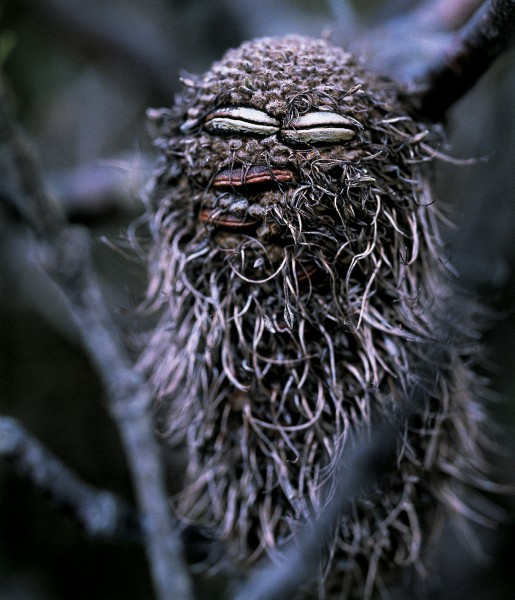
The word “Tarkine” refers to the Aboriginal Tarkiner people, who used to inhabit the area. Middens, pteroglyphs and ochre mines are a reminder of their occupation of the land, a presence stretching back 36,000 years. A land bridge existed across what is now Bass Strait at various times between 36,000 and 29,000 years ago, and between 20,000 and 8000 years ago, allowing a flow of people (and wildlife) between Tasmania and the rest of the continent.
The Tarkiners lived in caves and bark-covered tent-like shelters and hunted marine mammals, such as fur seals and elephant seals, as well as wombats and wallabies, even climbing trees to catch possums. Curiously, although they gathered shellfish and crayfish, they didn’t eat finfish.
It is impossible to reflect on the immense timescale of the Aboriginal presence in Tasmania without also shuddering at the speed of its termination—that episode of near genocide that constitutes what one writer has called the “sacred wound” of Australia. It is astonishing to think that a mere 10 years before the British Crown signed a treaty guaranteeing the rights of the indigenous people of Aotearoa, across the Tasman there was a bounty of £5 per head on the Aborigines—the same price that would later be placed on the thylacine. As in New Zealand, the colonial lust for land was insatiable, and the nomadic Aborigines, whose hunter-gatherer lifestyle required a large land area for viability, were simply in the way— “a menace to the stock-holders of the colony,” writes historian Lloyd Robson. In the notorious Black Line of 1830, some 2500 soldiers and auxiliaries formed a human dragnet that swept down the eastern half of Van Diemen’s Land, aiming to herd any remaining natives into Port Arthur. They caught just two, but the inhumanity of the action so demoralised the surviving Aborigines that they willingly allowed themselves to be deported to Flinders Island, in Bass Strait, where most of them died. The book that chronicles this sad history is well named: Weep in Silence.
[Chapter Break]
August is supposed to be an awful month in Tasmania. Meteorological records I consulted for the mountainous west and south-west gave a likelihood of rain nine days out of ten, and maximum temperatures of 9°C. Yet we had been spoiled with a week of fine, warm weather. It wouldn’t last, the Corinna punt operator had said, handing us a forecast printout that showed a succession of cold fronts stacked like incoming aircraft in the Indian Ocean. We figured we had a couple of days before the first “hangover” (as the punt man called it) afflicted us, so we headed for the high country.
The pleasure of walking in the mountains in Tasmania, as in New Zealand, is in part the enjoyment of a spectacular alpine flora. And, as in the forests, the similarities are striking. Cushion plants—some of them the same species encountered in our mountains—form thick green pillows that sprout constellations of white blossom in spring. Daisy bushes, tea tree, and a smaller version of our giant Spaniard speargrass all provide moments of recognition, as does a sprawling beech called tanglefoot or fagus, the only winter deciduous tree in Australia. Its corrugated leaves turn golden, then red, in autumn, reaching their peak colour around Anzac Day.
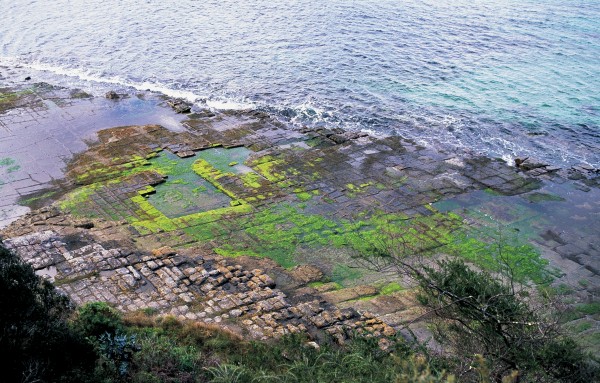
At the species level, however, the two alpine floras are quite different. A dominant genus in New Zealand’s mountains, for example, is Celmisia, the alpine daisy. We have more than 50 species, with a huge variety in plant form and leaf shape; Tasmania has but two species. We have close to 40 species of Aciphylla, members of the carrot family, such as the Spaniards; Tasmania has just one. We have 40 alpine hebes; Tasmania has none. There are no members of the Chionochloa tussock genus in Tasmania; New Zealand has close to 20 species. There are no Tasmanian genera that dominate to the extent that Celmisia, Aciphylla, Chionochloa and Hebe do in New Zealand—and this is a reflection of the explosive nature of speciation in this country, much of it in the last two million years. As the mountains began to rise and the glaciers to advance, species radiation went wild. Although Tasmania boasts a respectable level of endemism among its alpine plants (around half being peculiar to the island), more than 90 per cent of New Zealand’s alpine flora is endemic.
One of the unique features of the Tasmanian high country is the golden meadows of button-grass, a type of sedge named after its spiky button-sized seed-heads, which are borne aloft on slender 2 m stems. Buttongrass moorland covers a million hectares of plains and subalpine slopes in the west and south-west of Tasmania—a seventh of the total land area of the state. A high concentration of tannins and essential oils in the leaves makes buttongrass highly susceptible to fire and contributes much of the organic matter that gives he rivers their whisky tinge. This signature plant of the Tasmanian wilderness is absent from the New Zealand flora, its equivalent here being various tussocks.
The dominant rock type in the western mountains is dolerite, formed when massive upwellings of magma pushed through sedimentary rocks during the Jurassic. Its legacy is the craggy, frost-shattered peaks that inscribe the skyline of much of southern and western Tasmania, including such famous summits as Cradle Mountain and Mt Wellington (the imposing backdrop to Hobart), and climbers’ favourites such as the Acropolis, with its organ-pipe columns, and the Walls of Jerusalem.
In New Zealand, by contrast, dolerite has largely disappeared, stripped off the basement rocks by a combination of tectonic uplift and erosion. A few scraps remain, such as a rocky exposure north of Reefton, reported by geologist Hamish Campbell in New Zealand Geographic in 2000. Most of our mountains are younger than their Tasmanian counterparts, and have a blanket of greywacke or, in places, schist. Greywacke scree slopes (and their associated plants, such as penwipers and various species of buttercup) are a feature only on this side of the Tasman.

One of the characteristics of Tasmanian alpine landscapes is the way various types of vegetation dovetail to create a mosaic effect. Coniferous shrubberies, cushion-plant communities, sphagnum bogs, woody heath, herb fields—each is distinct but grades into the next. Tasmania doesn’t have the abrupt boundary between forest and alpine vegetation encountered in New Zealand, where it can seem as if a giant shaver has sheared off all tall timber above a neatly trimmed line. Tasmania has more cold-tolerant tree species than we do.
At altitude, the leaves of the mop-topped pandani, the tallest heath plant in the world, curl into shapely corkscrews as they age. A smaller-leaved relative, scoparia, one of the most ubiquitous shrubs in the heathlands, provides a gorgeous summer show of white, red, orange and pink inflorescences. Both are members of the genus Richea, which, according to recent DNA analysis by evolutionary biologist Steve Wagstaff (see sidebar), overlaps with the dracophyllums of New Zealand, Australia, New Caledonia and Lord Howe Island.
Heads down, walking into a biting wind, we threaded our way through a tarn-dotted landscape towards the Damascas Gate. In flat areas with nearby scrub, we noticed that alpine grasses had been cropped to a green sward—“marsupial lawns”—littered with the distinctive cube-shaped scats of wombats. Wallabies are also major grazers in alpine areas, hence the term “wallaby grass” for many species of Danthonia, including the widespread Luck of the Irish. Above us, eagles soared on thermals over Solomon’s Throne.
In alpine areas, one becomes aware of the importance of fire as a shaper of vegetation. Further west, in the Labyrinth, we had passed through areas where dead eucalypt crowns raked the sky. And here, clusters of Christmas-tree-shaped pencil pines survived only in nooks where flames hadn’t reached.
“A major problem for conservation management here is that a lot of the western Tasmanian Gondwanan elements are susceptible to fire,” Jamie Kirkpatrick, professor of geography and environmental studies at the University of Hobart, told me. “You have incredibly fire-sensitive species like pencil pine, King Billy pine and deciduous beech juxtaposed with the most flammable vegetation type in the world—buttongrass moorland—and you want to maintain both of them.
“The best thing seems to be to patch-burn the buttongrass in strategic locations so you break up the potential for a landscape-scale fire. In the past we’ve had fires that burned all the way from the north-west down to South West Cape. Absolutely disastrous. As recently as the 1960s a grazier’s burn-off got away and took out a huge area of pencil-pine forest in the Walls of Jerusalem. A tragic fire.”
I had sought out Kirkpatrick when I was in Hobart not just to talk about vegetation management—one of his many areas of expertise—but to get his views on the latest eruption of public protest. Only days before our meeting, the state government had given the go-ahead for a $2 billion pulp mill—the largest infrastructure project in Tasmania’s history—to be built in a wine-growing valley near Launceston. The decision had been greeted with equal parts delight and dismay. Tasmania stood divided, as always, over issues of development and environment.

Tall, tweed-jacketed, greying, Kirkpatrick is given to emitting great peals of laughter, usually as a result of considering the egregious actions of politicians. “Welcome to our warmongering nation,” he said by way of greeting, letting rip with a belly laugh.
“Our society’s mad, isn’t it?” he continued. “It’s clinically insane, thinking you can have never-ending economic growth from a finite planet. In Tasmania there are still large areas of old-growth forest being logged. It’s the whole growth-economy thing. They want more and more and more. Tasmania’s forestry industry has been felling native forest and putting in plantations at a rate of 10 to 20,000 ha a year—felling complex native forest and putting in crappy Eucalyptus nitens or Pinus radiata. They’ve also been taking over farmland and getting amazing tax concessions for putting in trees. You can’t get a tax concession for putting in an orchard that takes about the same time to get up, but you can for putting in Pinus radiata.”
Was there a potential middle ground, I asked, between the pro- and anti-logging factions? Was sustainable forestry ever likely to be acceptable in Tasmania?
“The Greens here say they don’t want to get rid of all logging. It’s just the old-growth forests they want left alone. There’s a huge area of forest that’s already been logged and could be managed sustainably. So, yes, from the point of view of democratic politics there is a middle ground that could be occupied, and has been occupied elsewhere. But whether it ever will be is an interesting question.
“Tasmania has been severely dichotomised. Conservation issues have brought down the state government several times. Although Tasmania has the highest green vote, running at around 17 per cent, the redneck vote runs at 83 per cent.” Another peal of laughter. “That doesn’t leave much middle ground.”
I had been following the pulp-mill debate in the Tasmanian media. Tasmanian novelist Richard Flanagan had accused the government of mortgaging Tasmania’s future to the wood-chipping industry. “Without an end to clear-felling,” he said, “our old-growth forest will share the fate of the Tasmanian tiger: a lost object of awe, one more symbol of our feckless ignorance and stupidity.”
The chief executive of the Forest Industries Association had countered by telling a pro-pulp-mill rally in Launceston that the Greens cared nothing about jobs, were jeopardising Tasmania’s image abroad and would not be satisfied “until we all sit back in caves knitting beanies”.
Kirkpatrick laid much of the blame for the polarisation of Tasmanian public opinion at the forestry industry’s door. “There have been missed opportunities right through the whole thing. I was involved in the strategy to get the original forestry agreement to include reservation-of-wilderness areas and old-growth, high-nature-conservation areas as a trade-off for being able to export wood chips. But the industry was greedy and didn’t take people’s feelings into account. The result is ongoing fights and bitterness.”
[Chapter Break]
A recent, acrimonious example had been the battle over the Styx Valley, site of the tallest trees in the Southern hemisphere. The tallest of the tall, a tree named Icarus’ Dream, was measured at 97 m in 2005, although even this cloud-scraper is some 20 m shy of the world record-holder, a Californian redwood. Several of Icarus’ Dream’s brethren, in a site known as the Andromeda Stand, exceed 85 m. All are mountain ash, Eucalyptus regnans, which tall-tree specialists acknowledge as the largest flowering plant in the world (redwoods, being conifers, are not in the flowering category). All have reached their maximum height, and, nearing the ends of their lives (at 400–450 years old), are in senescent decline, losing a few metres a decade.
On a morning when the ice on the potholes in the road shattered like plate glass under the wheels of our vehicle, we visited this valley of the giants. A sign at the entrance to what Forestry Tasmania has simply called the Big Tree Reserve noted that interpretation panels along the walkway had been removed “as a result of continual vandalism”. The notice itself had been vandalised, suggesting that the controversy over the felling of old-growth eucalyptus in the region still seethed.
The battle of the Styx peaked in the summer of 2003–04, when protesters staged a five-month tree-sit 65 m above the ground in a mountain ash they named Gandalf’s Staff (The Lord of the Rings being in vogue at the time.) A nearby ash was turned into a living Christmas tree, decorated with 3000 fairy lights and an enormous star.
At issue was the clear-felling of such prodigiously tall trees as these, and the flow-on effects to other species such as the endangered wedge-tailed eagle, which relies on old-growth-forest habitat.
Kirkpatrick told me a little of the background. “The criteria we developed for forest conservation included that a certain percentage of old-growth forest should be preserved within each forest type. Eucalyptus regnans is a forest type. The industry stuck in ‘flexibility provisions’ in the latter part of the discussions, which allowed them in the end to say these forests were too valuable to put in the old-growth system. So we’re now 14,000 ha short of old-growth forest for the regnans forest type—roughly the size of the Styx forests. It’s a morally indefensible position.”
During the protest, much was made of the name of the valley, with the prediction that if Forestry Tasmania’s giant-killing ways were not curtailed the whole area would become an underworld of ghost trees. In 2005 some of the targeted forest was reserved, but protesters claim it was a “postage stamp amount”, a fragment of conserved habitat surrounded by logged areas, regrowth and still-threatened forest.

Travelling back to Hobart, past freshly logged hillsides sporting signs that proclaimed “Productive forests proudly producing paper and timber,” I recalled something Kirkpatrick had written in his book A Continent Transformed: “Inquiry after Royal Commission after Inquiry have failed to resolve the basic conflict in values between those who wish to maintain our native forests for non-tangible use and those who wish to maximise timber output.” When we met, he left me in no doubt where he stood on the matter: “My position would be that we’ve destroyed too much of nature on this planet and we should bloody well stop.”
Keith Springer, a New Zealander who is managing a $25 million project to rid subantarctic Macquarie Island of rabbits, rats and mice—the Campbell Island rat eradication to the power of three—told me he thought green politics in Tasmania was 25 years behind that in New Zealand. “It’s still at the Whirinaki/Pureora stage,” he said, recalling the tree-sitting, bulldozer-blocking protests of the 1970s that led to the cessation of logging in state-owned native forests. “If a New Zealand government were to promote the chipping of old-growth forest today it would be voted out.”
Other Tasmanians I met said it was the practice of Tasmanian politics as much as the policies themselves that depressed them: disdain for the democratic process, cronyism, the acrid whiff of scandal.
The poet Walt Whitman once wrote: “After you have exhausted what there is in business, politics, conviviality, and so on… what remains? Nature remains.” Anyone who has walked in Tasmania’s forests—or in Fiordland’s—would surely say, “Long may it remain.” On both sides of the Tasman, preserved in two children of Gondwana,
two chips off the old block.







